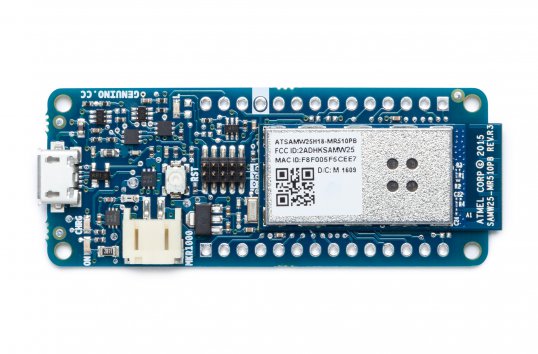Arduino MKR1000

|
Arduino MKR1000 offers a practical and cost effective solution for makers seeking to add WiFi connectivity to their projects to connect them to the Internet of Things. |

|
Arduino MKR1000 offers a practical and cost effective solution for makers seeking to add WiFi connectivity to their projects to connect them to the Internet of Things. |
Arduino MKR1000 has been designed to offer a practical and cost effective solution for makers seeking to add WiFi connectivity to their projects with minimal previous experience in networking. The design includes a Li-Po charging circuit that allows the Arduino MKR1000 to run on battery power or external 5V, charging the Li-Po battery while running on external power. Switching from one source to the other is done automatically.
MKR1000 has a good 32 bit computational power similar to the Zero board, the usual rich set of I/O interfaces, low power WiFi with a Cryptochip for secure communication, and the ease of use of the Arduino Software (IDE) for code development and programming. All these features make this board the preferred choice for the emerging Internet of Things battery-powered projects in a compact form factor. The board will be shipped with male strip header not mounted so you can adapt the board to your project by easily soldering them.
Important note. Unlike most Arduino boards, the MKR1000 runs at 3.3V. The maximum voltage that the I/O pins can tolerate is 3.3V. Applying voltages higher than 3.3V to any I/O pin could damage the board. While output to 5V digital devices is possible, bidirectional communication with 5V devices needs proper level shifting. Li-Po batteries are charged at 4,2V with a current that is usually half of the nominal capacity (C/2).
For Arduino MKR1000 we use a specialized chip that has a preset charging current of 350mAh. This means that the MINIMUM capacity of the Li-Po battery shall be 700 mAh. Smaller cells will be damaged by this current and may overheat, develop internal gasses and explode, setting on fire the surroundings. We strongly recommend that you select a Li-Po battery of at least 700mAh capacity. A bigger cell will take more time to charge, but won't be harmed or overheated. The chip is programmed with 4 hours of charging time, then it goes into automatic sleep mode. This will limit the amount of charge to max 1400 mAh per charging round.
| Microcontroller | SAMD21 Cortex-M0+ 32bit low power ARM MCU |
| Board Power Supply (USB/VIN) | 5V |
| Supported Battery(*) | Li-Po single cell, 3.7V, 700mAh minimum |
| Circuit Operating Voltage | 3.3V |
| Digital I/O Pins | 8 |
| PWM Pins | 12 (0, 1, 2, 3, 4, 5, 6, 7, 8, 10, A3 - or 18 -, A4 -or 19) |
| UART | 1 |
| SPI | 1 |
| I2C | 1 |
| Analog Input Pins | 7 (ADC 8/10/12 bit) |
| Analog Output Pins | 1 (DAC 10 bit) |
| External Interrupts | 8 (0, 1, 4, 5, 6, 7, 8, A1 -or 16-, A2 - or 17) |
| DC Current per I/O Pin | 7 mA |
| Flash Memory | 256 KB |
| SRAM | 32 KB |
| EEPROM | no |
| Clock Speed | 32.768 kHz (RTC), 48 MHz |
| LED_BUILTIN | 6 |
| Full-Speed USB Device and embedded Host | |
| LED_BUILTIN | 6 |
| Lenght | 61.5 mm |
| Width | 25 mm |
| Weight | 32 gr. |